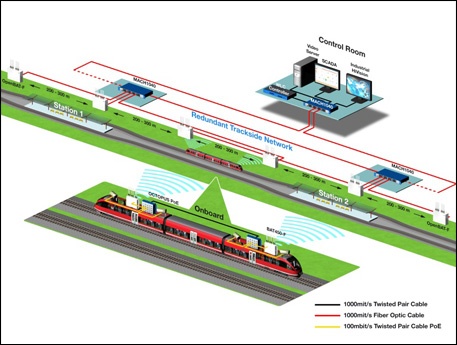Wireless Infrastructure for Train Control Systems
As a result many rail operators are striving to improve capacity without having to take on expensive and disruptive civil engineering projects. One solution is Communications Based Train Control (CBTC) systems which increase utilization of existing rail infrastructure.
Let’s consider the architecture of CBTC applications and the wireless infrastructure needed to support these train control systems.

The need to increase capacity without doing capital projects is driving the demand for Communication Based Train Control (CBTC) applications. CBTC systems improve the utilization of existing rail infrastructure. (Image Courtesy of NYdailynews.com)
Communications Based Train Control (CBTC) Systems Reduce Capital and Operating Costs
Traditionally, increasing the capacity on an urban rail network involved projects like laying additional running lines, boring new tunnels and lengthening platforms to enable the running of longer trains. These large civil projects are not only expensive; they are also potentially disruptive to operation services.
Through the use of exact, real-time, train positioning information, CBTC provides a solution to the capacity challenges and avoids the need for many civil engineering capital projects.
An increased utilization of the existing rail infrastructure is realized through the removal of traditional fixed signaling blocks. Instead, the train headways as well as speed and acceleration profiles are managed continuously in real-time. A CBTC system managing shorter, lighter, faster trains running more closely together will result in an increase in capacity over longer trains running on a fixed block signaling system.
Besides the benefits of lower capital outlays and a faster Return on Investment (ROI) than civil engineering projects, CBTC systems help reduce operating costs. A large proportion of the total cost of running rail passenger vehicles is fixed for long durations (such as vehicle leasing or finance costs). Fuel or energy usage very often represents the largest proportion of costs that the operator can control.
The use of a CBTC system allows energy savings to be made through the application of different driving profiles (such as coasting and reduced acceleration curves) when passenger demand is less, at off peak travelling times for example. When coupled with passenger counting technology, this management of the rail vehicles can be made fully automatic.
CBTC Train Control Systems Architecture
The typical architecture of a modern CBTC system comprises the following control subsystems:
- ATP: Automatic Train Protection
- ATO: Automatic Train Operation
- ATS: Automatic Train Supervision
Depending on the supplier, the architecture for these subsystems may be centralized or distributed. The ATS is usually in a central command center, though local control systems may also be included as a fallback.
The control subsystems are organized into logical components as shown below:
|
Logical Component |
Subsystem |
Functionality |
|
Onboard Equipment |
ATP |
Continuous control of the train speed according to the safety profile Communicates with the Wayside ATP to exchange information needed for safe operation |
|
Onboard Equipment |
ATO |
Responsible for automatic control of the traction and braking effort to keep the train under the threshold established by the ATP |
|
Wayside (Trackside) Equipment |
ATP |
Manages communications with the trains in its area; critical for operational safety |
|
Wayside (Trackside) Equipment |
ATO |
Controls the destination and regulation targets of every train |
|
Command Center Equipment |
ATS |
The interface between the operator and the system Event and alarm management Interface with external systems |
|
Train to Wayside Communication |
|
Communication most commonly based on IEEE 802.11 wireless radio links |

Shown above are the logical components of a CBTC system. High speed, reliable transmission of data is achieved by using industrially hardened Belden cable and Hirschmann networking equipment.
Wireless Infrastructure for Train-to-Ground Communications
The CBTC system communication infrastructure runs over a digital networked radio system by means of bi-directional communication between the track equipment and the trains. The 2.4GHz band is commonly used in these systems (public Wi-Fi band), though other alternative frequencies such as 900 MHz (US), 5.8 GHz or licensed bands may be used as well. LTE technology is also now also being considered with several signaling suppliers testing LTE-based CBTC systems.
While the use of wireless technology for CBTC is commonplace, it is not without its challenges, many of which stem from the demanding environment and the speed of moving trains. Some key requirements of the CBTC wireless network are listed in the table below.
|
Requirements |
Benefits |
|
Appropriate Railway Onboard Vehicle Certification
|
A pre-requisite for installation onboard train builders' vehicles or trackside and for implementation by systems integrators. |
|
Fast Secure Roaming |
For safety reasons, any disruption in the CBTC service will bring trains to a stop. Because of this, a roaming handover time of <50 ms is essential to provide uninterrupted train-to-ground communication. |
|
Error Tolerance |
While the communications system for CBTC is not defined as safety-critical, loss of the data being transmitted will result in system errors, so a packet loss of less than 0.1% is required. |
|
Sufficient Bandwidth |
The communication system must be capable of carrying all of the required data from the train to the Operational Control Center for the CBTC system to be reliable. To provide this service, a bandwidth of at least 4 Mbit/s is required. |
|
Network Latency |
Since the CBTC operation relies on real-time information for the control of moving trains, the maximum latency from end to end must be less than 5 ms. |
|
High Availability |
Train Control Management applications such as CBTC need communications networks with a high availability. |
|
Security |
CBTC networks require protection against malicious behavior and attacks. The network should be hardened against attacks that can threaten overall availability and performance. |
Shown above are the performance requirements for wireless infrastructure for train control systems.
Train Control Systems Need Reliable Wireless Infrastructure
As train travel options increase and railways seek to maximize capacity there is increased need for secure, reliable connections between moving trains and ground systems. It is clear that the communications link between the train and the ground infrastructure is critical for success.
Even as this demanding environment evolves, the impact of a system failure will affect thousands of people and have serious financial consequences. Therefore, choosing the right networking components and cable, like those from Belden, takes on even greater importance to ensure safety, reliability and network resilience.
To learn more about the wireless train-to-ground communication for CBTC as well as for Passenger Information Services and Surveillance Video applications, download the white paper available below.
Have you implemented wireless train-to-ground systems? If so, how have they performed? We look forward to hearing from you.
Belden Products for Industrial Wireless and Transportation